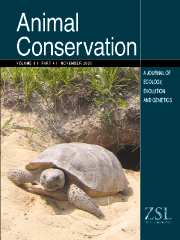Crossref Citations
This article has been cited by the following publications. This list is generated based on data provided by
Crossref.
Vargas, Julieta
and
Simonetti, J.A.
2004.
Small mammals in a tropical fragmented landscape in Beni, Bolivia.
Mammalian Biology,
Vol. 69,
Issue. 1,
p.
65.
Brito, Daniel
Oliveira, Leonardo C.
and
Mello, Marco Aurélio R.
2004.
An overview of mammalian conservation at Poço das Antas Biological Reserve, southeastern Brazil.
Journal for Nature Conservation,
Vol. 12,
Issue. 4,
p.
219.
Brito, Daniel
2005.
The importance of sound biological information and theory for ecological economics studies valuing Brazilian biodiversity: A response to Mendonça et al. (2003).
Ecological Economics,
Vol. 55,
Issue. 1,
p.
5.
Brito, Daniel
and
da Fonseca, Gustavo A. B.
2006.
Evaluation of Minimum Viable Population Size and Conservation Status of the Long-furred Woolly Mouse Opossum Micoureus paraguayanus: An Endemic Marsupial of the Atlantic Forest.
Biodiversity & Conservation,
Vol. 15,
Issue. 5,
BOTTIN, Lorraine
LE CADRE, Solenn
QUILICHINI, Angélique
BARDIN, Philippe
MORET, Jacques
and
MACHON, Nathalie
2007.
Re-establishment trials in endangered plants: A review and the example of Arenaria grandiflora, a species on the brink of extinction in the Parisian region (France).
Ecoscience,
Vol. 14,
Issue. 4,
p.
410.
Brito, Daniel
and
da Fonseca, Gustavo A.B.
2007.
Demographic consequences of population subdivision on the long-furred woolly mouse opossum (Micoureus paraguayanus) from the Atlantic Forest.
Acta Oecologica,
Vol. 31,
Issue. 1,
p.
60.
O’Brien, Clare M.
Crowther, Mathew S.
Dickman, Christopher R.
and
Keating, Joshua
2008.
Metapopulation dynamics and threatened species management: Why does the broad-toothed rat (Mastacomys fuscus) persist?.
Biological Conservation,
Vol. 141,
Issue. 8,
p.
1962.
Ozgul, Arpat
Oli, Madan K.
Armitage, Kenneth B.
Blumstein, Daniel T.
and
Van Vuren, Dirk H.
2009.
Influence of Local Demography on Asymptotic and Transient Dynamics of a Yellow‐Bellied Marmot Metapopulation.
The American Naturalist,
Vol. 173,
Issue. 4,
p.
517.
Zeigler, Sara L.
Fagan, William F.
DeFries, Ruth
and
Raboy, Becky E.
2010.
Identifying Important Forest Patches for the Long-Term Persistence of the Endangered Golden-Headed Lion Tamarin (Leontopithecus Chrysomelas).
Tropical Conservation Science,
Vol. 3,
Issue. 1,
p.
63.
Zeigler, Sara L.
De Vleeschouwer, Kristel M.
and
Raboy, Becky E.
2013.
Assessing Extinction Risk in Small Metapopulations of Golden‐headed Lion Tamarins (Leontopithecus chrysomelas) in Bahia State,Brazil.
Biotropica,
Vol. 45,
Issue. 4,
p.
528.
Heinrichs, Julie A.
Bender, Darren J.
Gummer, David L.
and
Schumaker, Nathan H.
2015.
Effects of landscape and patch-level attributes on regional population persistence.
Journal for Nature Conservation,
Vol. 26,
Issue. ,
p.
56.
Zanin, Marina
Palomares, Francisco
and
Brito, Daniel
2015.
The jaguar's patches: Viability of jaguar populations in fragmented landscapes.
Journal for Nature Conservation,
Vol. 23,
Issue. ,
p.
90.
Layton-Matthews, Kate
Griesser, Michael
Coste, Christophe F. D.
and
Ozgul, Arpat
2021.
Forest management affects seasonal source-sink dynamics in a territorial, group-living bird.
Oecologia,
Vol. 196,
Issue. 2,
p.
399.
Castilheiro, Welvis Felipe Fernandes
Muñoz-Muñoz, Francesc
Ventura, Jacint
dos Santos-Filho, Manoel
Mathias, Maria da Luz
and
Gabriel, Sofia Isabel
2022.
Differential Impact of Forest Fragmentation on Fluctuating Asymmetry in South Amazonian Small Mammals.
Symmetry,
Vol. 14,
Issue. 5,
p.
981.


